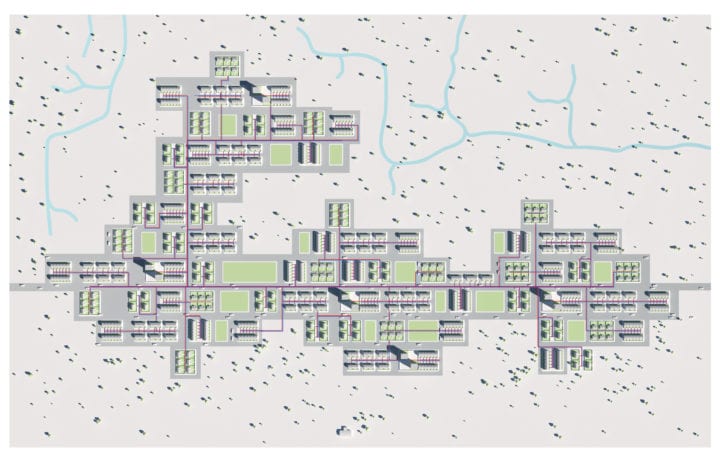Kensa Contracting specialises in the design and delivery of scalable, low cost and low carbon Fifth Generation District Heating and Cooling (5GDHC) networks featuring ambient Shared Ground Loop Arrays and decentralised ground source heat pumps.

Kensa Contracting specialises in the design and delivery of scalable, low cost and low carbon Fifth Generation District Heating and Cooling (5GDHC) networks featuring ambient Shared Ground Loop Arrays and decentralised ground source heat pumps.

A fifth generation district heating and cooling (5GDHC) network is a thermal energy supply grid, which circulates low grade heat sourced from the ground, the air, or waste heat processes, around a network of pipes to heat pumps. The heat pumps then upgrade this heat to deliver low cost and low carbon heating; the system can also work in reverse and provide cooling.
5GDHC networks are commonly referred to as Ambient Loops due to the ambient temperature circulating around the distribution pipework (-5°C to 20°C).
Fifth generation ambient loops have many advantages:
The most efficient heat source for fifth generation district heating is the ground. Ground source heat pumps using Shared Ground Loop Arrays are the most elegant, economical, and efficient heat source for fifth generation district heating ambient loops.
Air source heat pumps, dry air coolers (a fan) or sources of waste heat can also act as primary heat sources for ambient loops, however they require secondary appliances inside the property to manage and deliver the heating and cooling. Ground source heat pumps with Shared Ground Loop Arrays require no further appliances.
Ground source heat pumps can work with secondary appliances and no ground array i.e. using air source heat pump dry air coolers as the heat source, however the ground array provides design robustness and greater opportunities; the constant temperature of the ground provides stability unlike air temperature fluctuations, and depending on the geology the ground array provides the opportunity for natural energy storage.
Kensa’s innovative Shared Ground Loop Arrays are clusters of communal ground arrays, typically boreholes, which act as the heat source for an ambient loop, which in turn feeds low grade heat to decentralised Kensa Shoebox ground source heat pumps installed inside individual dwellings.
The Shared Ground Loop Array does not require any additional heat source or appliance other than the ground source heat pump; the ground source heat pump provides 100% of the properties heating and cooling needs all year round.
The use of ground arrays with ambient loops offers unparalleled opportunity for fifth generation district heating schemes to utilise waste heat as well as provide cooling. When ambient loops incorporate heat from waste heat sources, the load profile for the heating may not match that for the cooling requirement; the ground array therefore acts as a natural ‘heat store’ allowing for inter seasonal heat storage.
Kensa’s ambient Shared Ground Loop Arrays with decentralised Shoebox heat pumps have a number of advantages – to explore in full visit our page dedicated to Shared Ground Loop Arrays.
At a glance their benefits include:
The Government recognises that GSHPs are likely to be a strategically important technology for decarbonising heat, and anticipates potential for significant growth in deployment of this technology through the period to 2050.
The Government is keen to support the deployment of GSHPs making use of shared ground loops. This route (shared ground loops) will improve investment confidence and ............. will also offer the greatest flexibility, encouraging a broad range of shared loop projects to come forward including new build and mixed use projects.Department for Business, Energy & Industrial Strategy, 'THE RENEWABLE HEAT INCENTIVE: A REFORMED SCHEME: Government response to consultation', (December 2016)
Kensa’s Ambient Shared Ground Loop Arrays are an award-winning and pioneering approach to Fifth Generation District Heating and Cooling. The unique Shared Ground Loop Array design allows property owners and developers of two or more dwellings to realise the full potential of ground source heat pumps whilst achieving easier and cheaper carbon compliance for both…